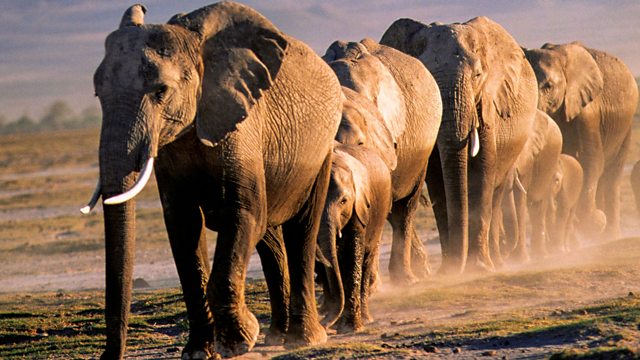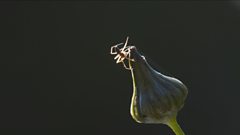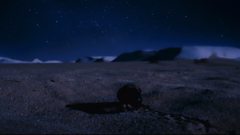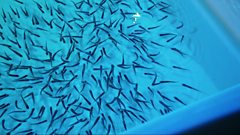
Travellers
Chris discovers the cleverest animal travellers and how they find their way, from deer with mental maps, blue whales planning routes, and dung beetles navigating by the stars.
Chris Packham discovers the clever methods that animals use to travel from A to B and how they find their way. Whether it is a local trip to find food or an epic journey to reach a safe place to breed, every traveller must work out where to go and the most energy-efficient way to get there.
Now, the latest scientific research is helping uncover just how they do it, from creating mental maps of their environment to planning their route with precision. We are only starting to understand how these intelligent travellers get around successfully, but by studying their movements we may also learn valuable insights that could help us, like ways to manage crowd safety and to how to tackle cancer more effectively.
Chris begins by meeting Bertie and Baxter, two beautiful Bactrian camels that demonstrate how they are perfectly adapted to trekking across harsh deserts. With long eyelashes and special eyelids to keep out sand, broad feet so they do not sink, and the ability to go without water for up to a week, these camels can cover 25 miles a day, and helped humans travel and trade for thousands of years.
In America, Rhiannon Jakopak from the University of Wyoming is part of a research team collaring and tracking mule deer across the state. They are finding that mule deer are constantly collecting details about the environment and their position within it, allowing them to learn migration routes passed down the generations, and even occasionally learning their own new routes.
Some ocean migrants are also showing impressive brainpower, as Dr Briana Abhrams from the University of Washington has discovered. Her research has shown blue whales use their memories to migrate, letting them predict where and when there will be a steady supply of food all along the west coast of North America, as they undertake their epic 4,000-mile-long migration.
Elephants have a reputation for never forgetting, and it seems their memory can help them find valuable resources. Sophie Sadera is a safari guide in the Maasai Mara National Reserve and she knows first-hand how elephants use the same pathways every year as they travel to find water. During times of drought matriarchs can use their memory of water sources they have visited in the past to ensure their herd鈥檚 survival.
But you do not need to have a big brain to find your way around. The green and black poison dart frog lives in the rainforests of South America and is a master of mental maps. Brand new science has shown this tiny amphibian has got the mind to remember the structure of a rainforest, which is constantly changing, enabling them to transport their tadpoles to water sources within this dynamic environment.
Exciting new research by Rickesh Patel, from the University of Maryland Baltimore County, has revealed an excellent underwater navigator. By constantly monitoring the turns they take and the distance they travel, mantis shrimp can find their way back to their home. This suggests they use a navigational strategy called path integration. They are currently the only underwater animal that we know of that is able to do this.
Professor Marie Dacke, from Lund University in Sweden, has been studying dung beetles in South Africa for over 20 years, and her research has discovered that these insects have the remarkable ability to navigate at night using the light of the Milky Way.
Some animal travellers use the most surprising ways to get around, and new science by the University of Bristol has shown how spiders can fly. By detecting static electricity in the air, they float along on silk lines. They have been found an impressive 1,000 miles out at sea, and up to two-and-a-half miles high in the air.
But they are not the only surprising flyer, the Paradise Tree Snake can cover almost 100 metres in a single glide. Now, thanks to motion-capture technology, new research has revealed the science behind how they can glide and land safely.
Some of the most exciting discoveries are coming from studying how animals travel en masse. Dr Iain Couzin, from the Max Planck Institute in Germany, is showing that bird flocks and fish shoals tap into a 'group mind' influencing how they travel. Their behaviour may hold answers to some human problems, like how to manage crowd safety and even new ways to treat cancer.
Chris takes us on a trip into the remarkable world of animal travel. By getting up close and personal with some of the nature鈥檚 best travellers, Chris reveals the remarkable intelligence these Animal Einsteins use to journey around our planet.
Last on
More episodes
Previous
Next
You are at the last episode
Clips
-
![]()
Spiders of the skies
Duration: 02:50
-
![]()
Dung beetles use the Milky Way to navigate
Duration: 02:24
-
![]()
The genius of collective intelligence
Duration: 03:26
Music Played
-
![]()
David Felton, Israel Medina, Sample Magic
Under The Sun
Credits
| Role | Contributor |
|---|---|
| Presenter | Chris Packham |
| Producer | Jim Turner |
| Series Producer | Joanne Stevens |
| Executive Producer | Rosemary Edwards |
Broadcasts
- Sun 28 Mar 2021 19:00
- Tue 30 Mar 2021 23:30麻豆官网首页入口 Two except Northern Ireland & Northern Ireland HD
- Thu 22 Apr 2021 08:00
- Wed 10 May 2023 20:00
- Mon 15 May 2023 02:20




